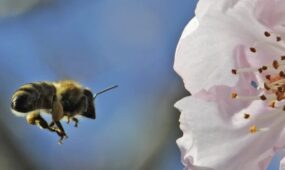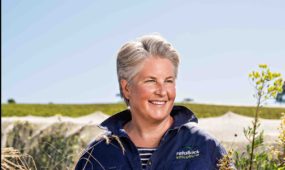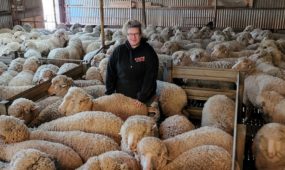Early smoke taint research begins in Australian wine regions
Primary Industries
Research into early identification of smoke taint damage on wine grapes has begun in Australia after devastating fires that have threatened harvest quality at hundreds of vineyards around the nation.

Sign up to receive notifications about new stories in this category.
Thank you for subscribing to story notifications.
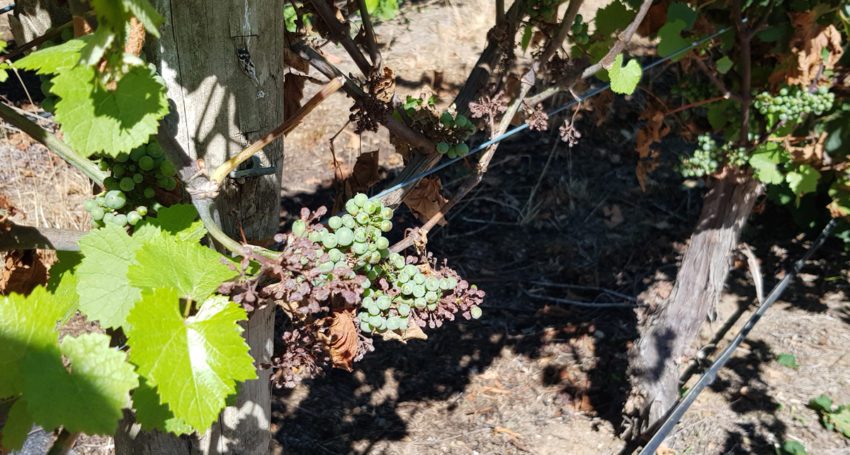
The Australian Wine Research Institute in South Australia is already considered a world leader in smoke taint research, an area that has received much attention in recent years following fires in many wine producing countries including the United States, South Africa, Portugal and Canada.
The December 20 Adelaide Hills fire just east of the South Australian capital, burnt through 25,000 hectares of land and destroyed more than 70 homes, 400 out buildings and 200 vehicles.
A third of the region’s 3000ha of vineyards are within the fire scar with about 500ha of vines across 60 vineyards, mainly in the northern parts of the region, sustaining direct fire damage.
However, growers are anxious to know if widespread smoke clouds during and after the fire have tainted grapes at hundreds more vineyards, making their crops effectively worthless. This year’s harvest is due to begin in February with sparkling and white varieties and run through until late March when red wine grapes are picked.
Identifying a crop’s commercial viability as early as possible after a smoke event can save growers thousands of dollars in costs on spraying, trimming and picking a potentially worthless crop.
At the time of the December fire, grapes on the vines were slightly smaller than pea-sized and were pre-veraison, which is a viticulture term meaning before the onset of ripening and the crucial development of sugars.
Unlike previous studies, which have focused on smoke events around the time of harvest, the AWRI research began this week by taking leaf and berry samples from three varieties – Chardonnay, Shiraz and Pinot Noir – from eight vineyards.
Three of the vineyards are in the direct fire zone, three are in areas outside the zone that were exposed to significant smoke drift and two are at the other end of the region, some 40km to the south, and are being viewed almost as control sites.
The first samples were taken this week. Further samples will be taken from all sites at the end of the month and again when the fruit matures.
Early test results will be shared with growers to potentially ease their concerns but there are no guarantees that a lack of smoke taint markers in pre-veraison berries will mean no taint will be present when mature grapes are made into wine.
AWRI Group Manager Research Dr Markus Herderich is leading the trial and said there had previously only been a small amount of testing using model smoke on pre-veraison grapes in the past, which had shown only small amounts of uptake.
He said the early testing would look for smoke compound markers in the leaves and immature grapes and then compare those results with sensory results from up to 24 test ferments when the harvested grapes are made into wine.
“No one really had any information about the risk profile and everyone wanted to look as early as possible at the grapes so they could make commercial decisions – do you harvest and what do you do with the grapes?” Dr Herderich said.
“If you are a winery buying someone else’s crop you probably have very little appetite of buying grapes that come with a risk of developing smoke taint in wine, but if you are growing your own crop you might take a different view on it.
“Ultimately it comes back to the decision of when do you cut your losses and it comes back to having early enough information to make key decisions that will ultimately affect your cash flow.
“Personally I hope that current wisdom stands up and if we don’t get more fire and smoke events then it will turn out from a taint perspective to be probably better than what people fear.”
Smoke tainted grapes can lead to highly undesirable “ashtray” flavours when made into wines. Some wineries have already begun sending letters to growers warning that they will not be paying for grapes found to be tainted.
The AWRI is also doing a small-scale trial of three vineyards in the New South Wales region of Hunter Valley following fires in November.
However, ongoing fires in New South Wales and Victoria into December and January are likely to make those results inconclusive because it will be difficult to tell which smoke events caused potential smoke taint markers in the Chardonnay and Shiraz grapes being tested.
Separate research is also being done in affected Victorian wine regions where smoke detectors are being used to measure smoke doses and align it with data to make a smoke taint prediction.
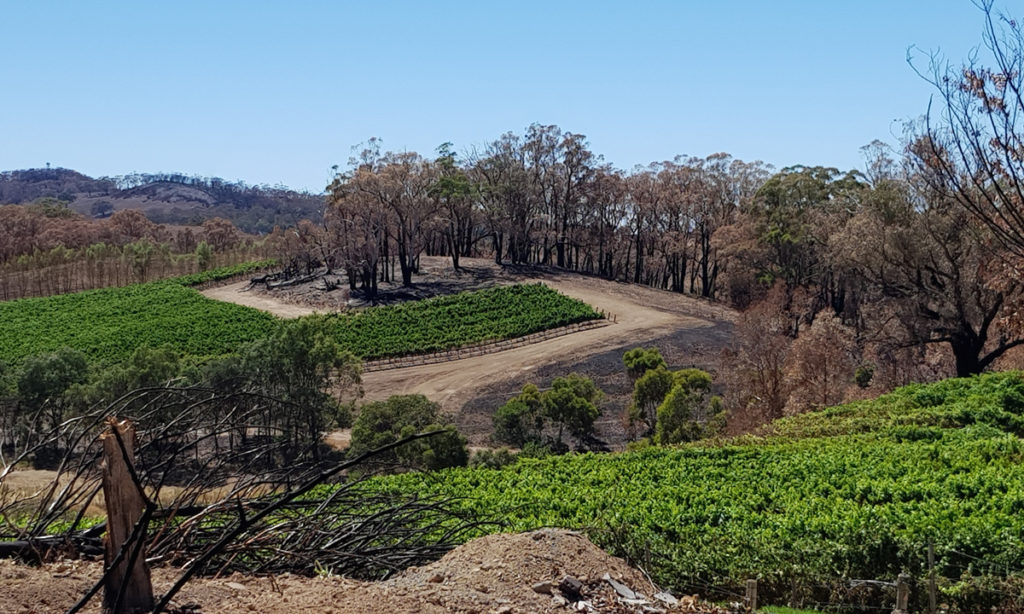
A number of vines in this Adelaide Hills vineyard near Lobethal are being cut down due to fire damage while some potentially salvageable grapes will be tested for smoke taint.
Shiraz and Chardonnay are the most commonly red and white varieties grown in Australia while Pinot Noir was also chosen in the Adelaide Hills trial because it is commonly grown in the cool climate region and is also made differently.
Dr Herderich said the variety and how it is made into wine often had a significant impact on how the taint showed.
“Most of the taint compounds tend to sit in the skins of grapes so with Chardonnay it’s a double-sided sword as it is typically made by pressing the fruit as gently and as early as possible,” he said.
“So that’s good in a sense because a lot of the taint compound never makes it into the wine and you can’t do that with the red varieties because you’ll lose most of the colour, which comes from the skins.
“However, with Chardonnay even a little bit of smoke stands out much more because of the subtle flavours of Chardonnay and the fact it isn’t usually exposed. With Shiraz you would typically use much more oak and younger oak. Shiraz as a variety has a few smoky odours as well so we speculate that it can tolerate some level of smokiness.
“Pinot Noir is a red wine that is made in a different way – you wouldn’t use the same type of oak, it is typically lighter bodied and you wouldn’t expect a lot of smoky aromas in it.”
The test batches from the Adelaide Hills trial will likely be bottled between June and September with sensory evaluation completed towards the end of the year.
Dr Herderich said the project aimed to be a short, sharp one-year study so the information would be available to growers and winemakers ahead of 2021 harvest.
He said Adelaide Hills winemaker Peter Leske had been instrumental in pushing for the trial, which came about following a meeting of growers in Hahndorf only a few days after the fire.
The AWRI is located at the University of Adelaide’s Waite Campus, on the edge of the Adelaide Hills.
The Institute has underwritten the cost of the sampling but it is yet to be determined how the full project will be funded.
Leske runs contract winery Revenir Winemaking between Lenswood and Woodside and said growers were frustrated that the fire event had happened two to three months before harvest, with current research forcing them to wait at least until veraison before knowing the fate of their grapes.
He said this coupled with the fact the fire-affected region was “in the institute’s backyard” made it a perfect chance to further global research.
“This was an opportunity to do the work that involves taking fruit samples earlier than they’ve been taken before and on repeat occasions so we can determine whether or not the taint compounds are present early, what happens to them as the fruit matures and ultimately ripens,” Leske said.
“We probably will see some more early fire events but the notion here is to get this analysis done so growers in the future no longer have to spend money spraying, shoot lifting, bunch thinning or whatever else they were going to do.
“They can put an end to the haemorrhaging, manage the vines into the next season and start again rather than just not knowing how much to continue to spend on a crop that might end up being worthless.”
Jump to next article
